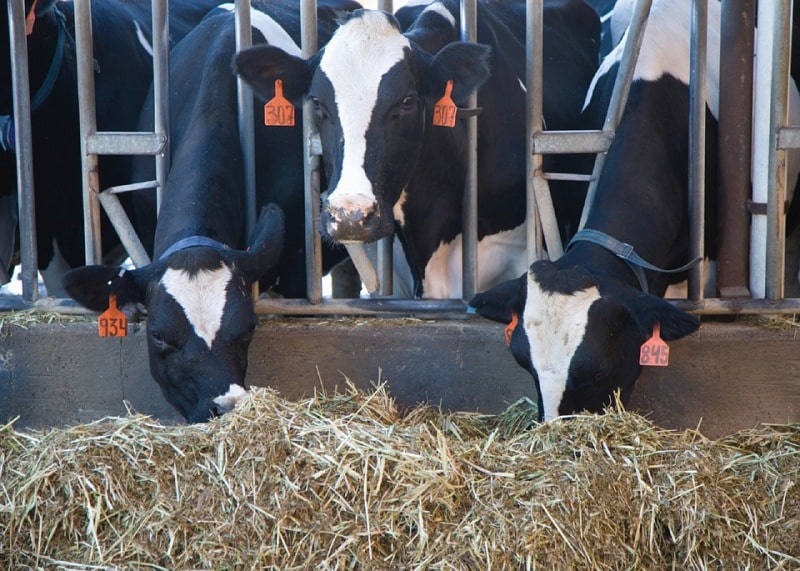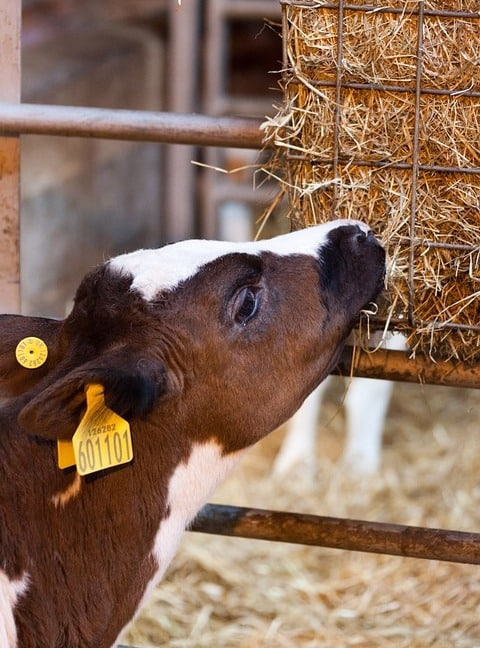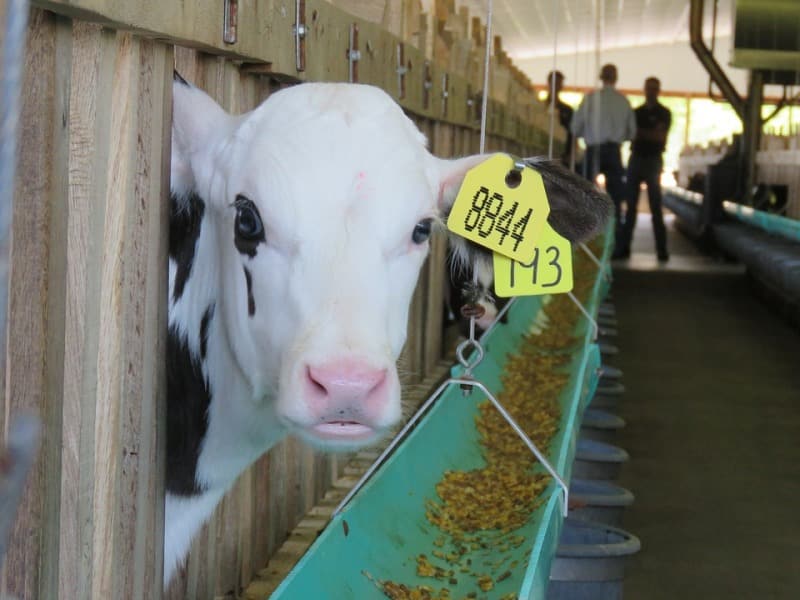A guide for Nutrition Management, Dairy Animal Feed
Animal feed is the food given to animals which are domestic often refers to fodder in the course of care and management of dairy farm animals by humans for profit. Supply of quality feed ensures the health of dairy animals.
Here we discussed,
- Feed management in dairy animals
Feed management in dairy animals:

Feeding is a very important aspect of dairying as it accounts for around 70% of the total cost of milk production. Different types of dietary feed ingredients for dairy cows and buffaloes contain concentrates such as compound cattle feed, oil cakes, grains and their byproducts like brans and chunnies; cultivated green fodders and grasses; crop residues like straws and stovers.
Following sections are explained about feed management in dairy animals;
- Dairy feeding and general recommendations
- Dairy animal Nutrition
- Ration Balancing Programme
- Bypass protein feed in dairy animals and their importance
- Feeding mineral mixture and its importance
- Urea Molasses Mineral Block Licks
- Importance of drinking water in dairy animals
- pregnant dairy animals care
- Nutritional care after calving
- Total mixed rations (TMR).
Dairy feeding and general recommendations:

- A normal adult animal must be fed 6 Kg dry and 15-20 Kg green fodder per day. Legume and non-legume green fodder must be fed in 1:3 proportions.
- Green fodder must be harvested at 50% flowering stage. Surplus green fodder must be conserved in the form of ‘hay’ or ‘silage’. Conserved fodder becomes helpful during summers or when green fodder is scarce.
You may also check Taiwan Guava Cultivation Profits.
1.General recommendations of dairy animal feed:
- To optimize milk production and to meet the nutrient requirement of animals, balanced feeding using user-friendly software developed by National Dairy Development Board (NDDB) can be adopted.
- Animals fed only on dry fodder can be provided Urea Molasses Mineral Block as a supplement to the diet, depending upon its availability.
- For body maintenance and higher efficiency of milk production, ‘compound cattle feed’ or ‘bypass protein feed’ should be given.
- Minerals are necessary for all metabolic functions of the body animals’ ration should be supplemented with area specific mineral mixture.
- Changing from one feed to another must not be sudden but in a gradual manner.
- Fodder must be chaffed before feeding, to avoid wastage and increase digestibility.
- Various feed ingredients including the additives must be mixed to make Sani or Total Mixed Ration (TMR). It would be more appropriate to feed this ration in 3 to 4 equally divided parts in a day. This could reduce spoilage and increases digestibility.
-
Dairy animal feed Nutrition:
Dairy farmers and herd nutritionists aim for 50 to 60% of the diet as forage. Forage is simply plants that are consumed mostly by grazing livestock, like grass or hay.
Groups of forages are two types. They are wet and dry. The main example of wet forage is silage, (fermented forage). Commonly, silage on a dairy farm could consist of barley, corn or alfalfa. Dry forages are consisting of pasture (fresh forage) or high-quality alfalfa hay, alfalfa-grass mix hay, grass hay or straw. Some dairy farmers will feed a mix of both silage and hay, while others might feed silage or only feed hay, depending on the farm.
The other half of the diet is known as concentrate. The concentrate is comprised of carbohydrates, proteins, fats, minerals, and vitamins.
Energy
Ruminants need a daily supply of all nutrients required for maintenance and production that are milk, meat, growth, and pregnancy. Quantitatively any type of nutrient can limit performance levels, but the most probable to be in short supply are energy and protein, this is especially true for high and average yielding cows. Both energy and protein should be considered. For energy, the feeding organism uses the metabolizable energy (ME) in the feed as a basis to formulate rations. The metabolizable energy is the energy remaining in the digested foodstuffs after the loss in feces, urine, gases and body heat. The essential unit used to measure the energy content is the Megajoule (N4J).
Carbohydrates
Primary sources are barley, corn, oats, wheat, molasses, beet pulp, and soy hulls. Most dairy farmers produce their own barley, corn, oats, and wheat and will often process these grains to be fed to the cows. Molasses, beet pulp, barley, and soy hulls are purchased from a feed mill. Not all of these carbohydrate sources are used as other sources are required to complement the forage to meet the nutritional requirements of the cows.
Protein
Primary sources are canola meal, distillers grains, soybean meal, and corn gluten meal.
Fat
Primary sources are vegetable oil, tallow, and protected fatty acids.
Minerals and Vitamins
Primary sources are Calcium, Phosphorus, Magnesium, Sodium, Chloride, Potassium, Sulfur, Iron, Zinc, Manganese, Copper, Cobalt, Iodine, Selenium, Vitamin A, Vitamin D, E, and some B-vitamins too. They are necessary for the health and productivity of the cows and farmers and nutritionists will make sure all of these nutrients are balanced. Prebiotics and probiotics are often used to help with digestion and as another way to ensure cows are healthy.
The carbohydrates, protein, fat, minerals, vitamins and feed additives are mixed together at a feed mill and brought to the dairy farm to be fed to the dairy cows.
Many of the ingredients are standard, but some dairy farmers that are closer to large centers can get the advantage of by-products from commercial food processors, such as potato waste, fruit and vegetable waste, etc. Dairy cows are recyclers and can take unwanted by-products that have great nutritional value and use them in diets though reducing the number of grain cows eat. Dairy animal care is taken on selecting ingredients that are healthy for dairy cows to remain productive and sustainable.
You may be interested in Dragon Fruit Farming Profit.
-
Ration balancing programme:
Farmers feed their animals based on their traditional knowledge and information passed through generations with crop residues, locally obtainable one or two feed ingredients like brans, oil-cakes, chunnies, grains, etc. and seasonally obtainable green fodders. They rarely offer mineral mixture to their animals or in a very less quantity of 25 – 50g per day. In most of the cases, the quantity of feed or fodder offered to animals is either more or less than the requirements. This leads to an imbalance of protein, vitamins, energy, and minerals in their ration. Animals on such imbalanced ration generate milk sub-optimally, cost of milk production is higher and it affects the health and fertility of animals. Therefore, it is essential to educate farmers on the feeding of balanced ration.
Farmers feeding balanced ration in different areas of the country have experienced an increase in their net daily income in the range of Rs 15 to 25 per animal.
Benefits of Ration Balancing Programme
- Proper use of locally obtainable feed resources at possible least cost
- Increases milk production with more fat and Solids Not Fat (SNF)
- Increase in net daily income
- Improves reproduction efficiency
- Reduces inter-calving period and increases the productive life of animals
- Improves the general health of animals
- Improves the growth rate in increasing calves, leading to early maturity
-
Bypass protein feed in dairy animals:
Bypass protein is also called as rumen escape or undegradable protein. It is the portion of the protein from a feedstuff that are corn, soybean meal, blood meal, etc. that escapes from being broken down or digested in the rumen by microbes (bacteria, protozoa, etc.).
Bypass protein feed is a new generation dairy feed in India and is manufactured by a special chemical treatment, developed by the National Dairy Development Board (NDDB).
Importance of bypass protein feed
- Proteins are necessary for growth and milk production.
- Generally, the main portion of the feed proteins is broken down in the first compartment (rumen) of the stomach.
- In case of bypass protein feed, a significant portion of the protein escapes break down in the first compartment and goes to the later element of the gastrointestinal tract resulting in better utilization of proteins in the body.
- Bypass protein feed can be arranged using chemically treated protein meals.
-
Feeding mineral mixture and its importance:
Minerals are essential for good metabolic functions. The mineral mixture contains all the necessary minerals in the required quantities. Feeding area specific mineral mixture must be preferred.
Benefits of feeding mineral mixture
- Helps improving growth rate in calves.
- Better utilization of absorbed nutrients.
- Increases milk production in animals.
- Improves reproductive efficiency and reduces inter-calving
- Increases the productive life of animals.
- Improves immunity status.
- Prevents metabolic diseases like milk fever, ketosis, haematuria, and etc., which occur around the calving period.
You may also check the Growing Tomatoes for Profit.
-
Urea Molasses Mineral Block Licks (UMMB):
Urea molasses mineral block is prepared by mixing urea, molasses, mineral mixture and other ingredients in an appropriate proportion. It is a readily obtainable source of energy, protein, and minerals for the dairy animal. Supplementing an animal with UMMB would give the adequate quantity of these nutrients and slow ingestion of urea leads to efficient microbial protein production and improved digestibility. NDDB has developed ‘cold process’ of manufacturing UMMB licks (three kg blocks) and the technology is being present to dairy cooperatives, private organizations, and other agencies. UMMB is useful for milk producers in green fodder deficit areas.
-
Importance of drinking water in Dairy animals:
Water Intake
Daily intake of water will vary according to an animal’s age, size, level of activity, and stage of productivity. Environmental temperature, humidity, water availability, and water quality can impact water intake. It should be recognized that a portion of the cow’s water comes from her ration. Less water quantity will be drunk from the water tank, as the ration gets wetter.
Water is required for;
- Digestion of feed and fodder.
- Distribution of absorbed nutrients to various organs.
- Excretion of undesirable & toxic elements through urine.
- Maintenance of body temperature.
- Generally, an adult healthy animal requires 75 to 80 liters of water daily.
- Since milk contains about 85% water hence two and a half liters water is necessary for every liter of milk produced.
Recommendations:
The animal must have free access to clean drinking water round the clock.
During summer, crossbred cows and buffaloes must be given bath twice daily and at least 100 liters of water per day to manage heat.
-
Pregnant dairy animal feed and care:
Here we explain pregnant dairy animals care and recommendations;
- Good feeding and management for the calves must be given so that they develop well and will become useful replacement stock.
- The feeding and taking care of the calf begins before its birth.
- The dam should be dried 6 to 8 weeks before the expected date of calving and should be fed well.
- Adequate health care and nutrition can ensure the rapid growth of female calf with attaining puberty at an early age. Timely insemination of such animals could help them to calve at 2 to 2 ½ years of age.
- As the fetus develops rapidly during the last three months of pregnancy, adequate care needs to be taken during this time.

Recommendations:
- Pregnant animals must have enough space for standing and sitting comfortably.
- Animals in the last trimester of pregnancy must not be taken far away for grazing; uneven paths should be avoided.
- A lactating animal must be dried within a period of 15 days after the 7th month of gestation.
- Pregnant animals need appropriate ration to reduce the possibility of diseases like milk fever and ketosis at the time of calving and to ensure adequate milk production.
- Water should be provided round the clock to pregnant animals with a minimum of 75 to 80 liters of fresh and clean drinking water daily.
- A heifer after 6 to 7 months of gestation should be tied with milking animals; and its body, back, and udder should be massaged.
- 4 to 5 days before calving, the animal should be tied in a separate clean and airy area having sunlight. Bedding materials like paddy straw must be spread on the ground for the animal.
- The animal must be kept under observation during the last 1-2 days before calving.
You can also check Goat Pregnancy Signs, Symptoms.
-
Nutritional care after calving:
- Immediately after calving, the cow or buffalo has a low appetite and will not eat as much feed as the body may require.
- Cow or buffalo undergoes a lot of stress while calving, therefore, the animal must be given light, palatable, mild laxative ration containing warm rice gruel, boiled rice or wheat bran, boiled millet or wheat mixed with edible oil, bypass fat, Jaggery, Soya, Asafoetida, Methi, Black Cumin, ginger etc. for 2 to 3 days after calving. This kind of diet is helpful in early expulsion of the placenta.
- In addition, the animal must be given tender green fodder and fresh water as much as it wants to drink, but do not give hot water.
- Ensure the milking cow has constant access to clean drinking water and receives an essential quantity of Area-Specific Mineral Mixture daily.
-
Total mixed rations (TMR):
Let us find out what is Total mixed rations and its benefits;
A TMR is a process of feeding cows that combines feeds formulated to a specific nutrient content into a single feed mix. The mix contains the following mentioned feeds.
- Forages
- Grains
- Protein feeds
- Minerals
- Vitamins
- Feed additives
Total mixed rations help dairy cows achieve maximum performance and are the most ordinary method for feeding high producing, indoor-housed dairy cows in the world.
Advantages of TMR:
Below we mentioned advantages of TMR;
- The dairy farmer has more control over the feeding course.
- All forages, grains, protein supplements, minerals, and vitamins are carefully mixed. Therefore, the cow can do little sorting for individual ration ingredients.
- Completely blended feeds, coupled with grouping the cows, permits greater flexibility in feeding exact amounts of nutrients like energy, protein, etc. to more accurately feed cows for their particular phase of lactation and level of milk yield.
- Grain mixtures can be substantially fed to grouped high producers without overfeeding the late-lactation cows, resulting in more efficient use of dairy animal feed.
That’s all folks about the feed of dairy animal and their nutritional management.
You may be interested in Growing Hydroponic Cucumber.
Let me know before food after food milk quality nd quantity???